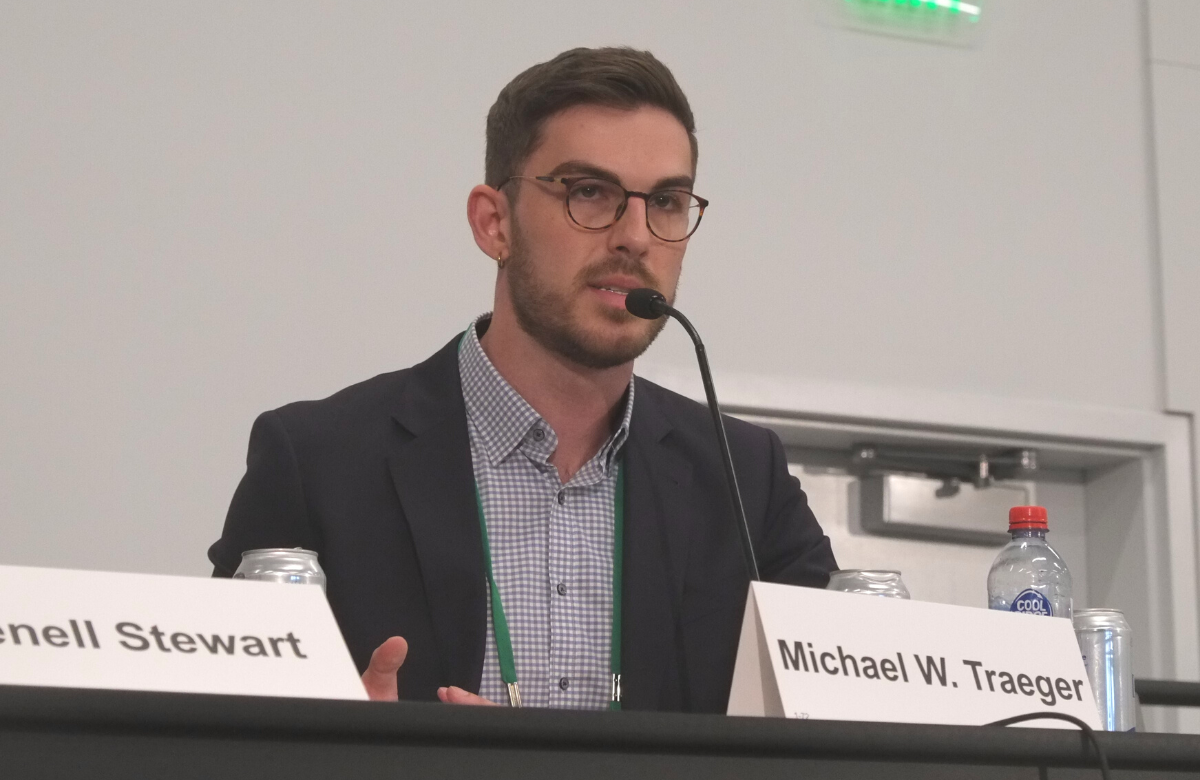Having problems reading this email? View it in your browser >>
|
||
 |
||
|
||
Contents
|
||
Mpox (monkeypox) can be very severe in people with uncontrolled HIV | ||
 Professor Chloe Orkin presenting at CROI 2023. Photo by Liz Highleyman. | ||
|
The findings come from a global case series presented at the 30th Conference on Retroviruses and Opportunistic Infections (CROI 2023) in Seattle and published simultaneously in The Lancet. The first cases in the recent mpox outbreak were reported in May 2022. Since then, there have been more than 86,000 cases in 110 countries, resulting in 96 deaths. Most cases have been among gay, bisexual and other men who have sex with men. Mpox case numbers have declined dramatically since the outbreak peaked in late summer, but cases may be underreported, mpox vaccination rates are low, and vaccines and antiviral treatment for mpox remain unavailable in many countries. The new case series compiled data from 382 HIV-positive people with mpox in 19 countries. About a quarter of the case reports came from Europe, nearly three-quarters from the Americas and less than 2% from Africa. Although about 90% were people previously diagnosed with HIV, just 60% were on antiretroviral treatment and only half had an undetectable viral load. Only 7% had received an mpox vaccine. Most people developed a skin rash, with the number, size and extent of the lesions much worse in people with low CD4 counts. There were nearly 400 cases of mpox among HIV-positive people with a CD4 count below 350. Many had severe necrotising lesions resulting in tissue death, and some had lung involvement and sepsis. Overall, 27 people (7%) died. But mortality was heavily concentrated among those with the most advanced immune suppression. Most of those who died had multiple severe mpox complications and their median CD4 count was only 35. No one with well-controlled HIV and no one who received a mpox vaccine died, which suggests that starting and staying on antiretroviral therapy can prevent severe outcomes. However, presenter Professor Chloe Orkin of Queen Mary University of London added a note of caution, advising clinicians who care for people with severe mpox to be alert for immune reconstitution inflammatory syndrome (IRIS), a worsening of symptoms that can occur when people start antiretrovirals with a very low CD4 count. Eight-five people either started antiretroviral treatment for the first time or restarted therapy and of these, 25% had suspected IRIS. Orkin and colleagues argue that mpox acts as an opportunistic infection in people with uncontrolled HIV and the severe necrotising form is an AIDS-defining illness. They called on the World Health Organization and the US Centers for Disease Control and Prevention to add mpox to the 14 other opportunistic conditions in international disease classifications. Dr Meg Doherty, head of the World Health Organization’s global HIV, hepatitis and sexually transmitted infection programmes, said the agency will review the data with international experts and consider the researchers’ recommendations. | ||
Dapivirine ring safe in third trimester of pregnancy and during breastfeeding | ||
 Dr Katherine Bunge at CROI 2023. Photo by Roger Pebody. | ||
|
Women can safely use the dapivirine vaginal ring for HIV PrEP in the third trimester of pregnancy and during breastfeeding, according to new studies presented this week at CROI 2023. The research is also the latest to reaffirm the safety of daily oral PrEP in pregnancy. Data from the Ring Study and ASPIRE Phase III studies originally showed the ring could reduce the risk of HIV infection by about 30%. Subsequent analyses found the monthly ring could reduce risk by as much as 75% among women who were best able to use it correctly and consistently. Women who became pregnant during these studies were quickly taken off the ring to avoid potential side effects, but data from these 240 participants found no increased risk of pregnancy or birth complications after having conceived while using the vaginal ring. Now, the first studies of the vaginal ring in late pregnancy and breastfeeding confirm the dapivirine vaginal ring is safe to use for women in their third trimester of pregnancy or while breastfeeding, and poses no safety concern for infants. The DELIVER study recruited pregnant women aged 18 to 40 in Uganda, Malawi, Zimbabwe and South Africa. Participants were randomly assigned to receive either the vaginal ring or daily oral PrEP. The study used a three-phased approach, first enrolling 150 women whose advanced pregnancies put them at the lowest risk of experiencing drug-related complications: those at 36 weeks of pregnancy. After an independent review panel found no safety concerns for this group, a second cohort of 157 participants at 30 to 35 weeks of pregnancy was started on the trial and subsequently 250 people between 12 and 29 weeks of pregnancy. Both the ring and daily oral PrEP were found to be safe. A companion study, called B-PROTECTED, looked at drug levels in blood and breast milk and found that women can also safely breastfeed while using the silicon ring or oral PrEP. Regulatory bodies in South Africa, Uganda and Zimbabwe have given the ring the green light. These and other African countries plan to pilot the ring in implementation studies alongside oral and injectable PrEP. Researchers say these results should give regulators and policymakers the confidence to include pregnant and breastfeeding people in roll-outs of the vaginal ring. | ||
Swiss study finds integrase inhibitors do not raise cardiovascular risk | ||
 Dr Bernard Surial at CROI 2023. Photo by Andy Carstens. | ||
|
The question of whether integrase inhibitors affect cardiovascular risk has been uncertain. Although integrase inhibitors are less likely to cause increases in cholesterol, people with HIV taking integrase inhibitors tend to gain more weight after starting treatment than others, which might raise the risk of cardiovascular disease. Previous studies have produced contradictory findings. For the new study, researchers assessed the risk of a serious cardiovascular event (stroke, heart attack or an invasive procedure such as angioplasty or stenting) in people with HIV who started treatment in Switzerland after May 2008. During the study period, 5362 people started HIV treatment, 1837 with an integrase inhibitor-based regimen and 3525 with another type of regimen. More than half of people who started an integrase inhibitor received dolutegravir (53%). The rest received bictegravir (18%), elvitegravir (16%) or raltegravir (13%). Approximately one in four people who started an integrase inhibitor-based regimen also received abacavir, compared to one in eight starting another regimen. Tenofovir alafenamide (TAF) was taken by 40% of people starting an integrase inhibitor but only 1% of those taking another regimen. Study participants who started with an integrase inhibitor or another drug class were evenly matched in most respects. The average age at start of treatment was 39, approximately half of participants smoked, 10% had high blood pressure and 1.5% had a previous history of cardiovascular disease. A higher proportion of those who started treatment with a non-integrase inhibitor regimen were women (24% vs 11% of people taking integrase inhibitors) and African (18% vs 11%). During a median follow-up period of 4.9 years, 116 cardiovascular events occurred. After adjusting for demographic, HIV-related and cardiovascular risk factors, the investigators found no significant difference in the risk of cardiovascular events at any time-point in follow-up. Presenting the results, Dr Surial said that larger international cohort collaborations should replicate this analysis. He drew attention to potential biases that could exist in previous studies of cardiovascular risk and integrase inhibitor treatment, including switching of people with co-morbidities onto integrase inhibitors to reduce the risk of drug-drug interactions. | ||
Prescribing doxyPEP after STI diagnosis more efficient than targeting specific groups | ||
 Dr Michael Traeger at CROI 2023. Photo by Roger Pebody. | ||
|
“Specifically in our cohort, we estimate that prescribing doxyPEP for 12 months following an STI diagnosis could have averted 42% of all STIs,” said Dr Michael Traeger of Harvard Medical School. Three clinical trials have shown that prescribing the antibiotic doxycycline to gay and bisexual men and transgender women within 72 hours of having condomless sex reduces STIs. DoxyPEP has shown relatively high effectiveness at preventing chlamydia and syphilis, but less effectiveness at preventing gonorrhoea in these groups. While the previous trials show reduced STIs at the individual level, this analysis aimed to investigate how community spread might shrink in response to different doxyPEP prescribing strategies. The research team evaluated STI test data for more than 10,500 people who accessed care between 2015 and 2020 at a large health centre in Boston that specialises in care for LGBTQ+ people. They estimated how applying hypothetical prescribing strategies would have reduced STI incidence. Making doxyPEP available to everyone in the study group after condomless sex would have prevented 70% of STIs, but would also have required everyone to take the drug – potentially increasing concerns about developing resistance. Strategies based on specific groups of people were less efficient than strategies based on STI diagnosis, needing a higher proportion of the group to avert infections. For example, prescribing doxyPEP to all people living with HIV and all people taking HIV PrEP had the potential to prevent 60% of STI infections in a year, but 68% of the clinic cohort would be taking the antibiotic. Strategies focusing on STI diagnoses would see smaller proportions of people needing doxyPEP. If it was prescribed after any STI diagnosis, 42% of new STIs could have been avoided. Prescribing to those who’d been diagnosed with two STIs in the past 12 months would have averted 23% of the groups’ infections with just 14% of people taking it. Traeger pointed out that the effectiveness of these strategies may differ in the real-world and in larger populations, but argued that the results point to ways of weighing benefits against potential harms when setting clinical prescription guidelines for doxyPEP. | ||
Mosaico trial closure shifts vaccine focus to neutralising antibodies | ||
 Professors Susan Buchbinder and Larry Corey at CROI 2023. Photo by Gus Cairns. | ||
|
The trial, which gave the vaccine or a placebo to 3900 cis and trans gay and bisexual men and trans women in the Americas and Europe closed in January, after concluding that the vaccine being tested was not effective at preventing HIV. “The unfortunate news was that there was no efficacy seen from the results of the trial and the HIV infection rates were actually quite high,” Buchbinder said during a press briefing. She reported that the overall HIV incidence was 4.1 per 100 person-years in both the vaccine and placebo arms of the study. The Mosaico trial tested a vaccine intended to produce non-neutralising antibodies. In contrast to neutralising antibodies that directly prevent a pathogen from spreading within the body, non-neutralising antibodies evoke immune responses that fight infection indirectly. Corey said that future research would focus on vaccine approaches that use neutralising antibodies, with seven or eight candidate vaccines being evaluated within the next two years to determine whether they can achieve levels of neutralising antibodies that might be high enough to protect against HIV infection. | ||
Connect with us |
||
|
NAM's news coverage of CROI 2023 has been made possible thanks to support from ViiV Healthcare. |
||
|
aidsmap is an award-winning, community-based organisation, which works from the UK. We deliver reliable and accurate HIV information across the world to HIV-positive people and to the professionals who treat, support and care for them.
NAM Publications
Cally Yard, 439 Caledonian Road, London N7 9BG Company limited by guarantee. Registered in England & Wales, number: 2707596 Registered charity, number: 1011220 To unsubscribe please click here Privacy Policy: www.aidsmap.com/about-us/confidentiality |